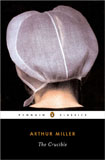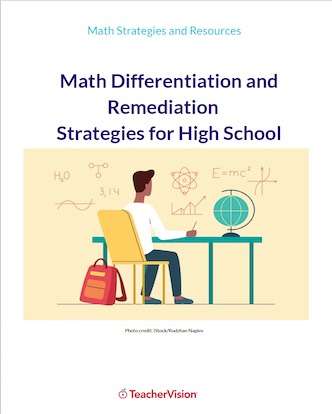The Crucible
by Arthur Miller
- The Life of Arthur Miller
- The Characters
- Overview
- Before Reading the Play
- While Reading the Play
- After Reading the Play
- Bibliography
- About the Guide Editors
- Buy this Book!
Enter promo code TEACH for 15% off.
The Crucible, by Arthur Miller, was written during the early 1950s. This was the time of Senator Joseph McCarthy's House Un-American Activities Committee hearings on the infiltration of Communism in the United States and the loyalty to democracy of many prominent U.S. citizens. The McCarthy hearings pitted artists and performers against each other as they were called to testify about their own loyalty and what they knew about the loyalty of others. Although some critics have suggested that The Crucible is an historical allegory for the McCarthy period, it can be examined more fruitfully as a play about the human condition. McCarthyism, as Miller himself said, is the backdrop for the play, but is not its theme. The approach of this teacher's guide will be to view the play as one that has outlasted the political turmoil of the time during which it was written, becoming a classic work that continues to excite and enrage audiences and readers.
The Crucible is set in another politically charged period in U.S. history. The Salem witch trials of the late 17th century resulted in the accusation and hanging of many colonials. Citizens of the Massachusetts colony were arrested and forced to admit their own guilt and inform on others. Whether or not the play is historically accurate is not important to the approach used in this teacher's guide. Although we will suggest ways to examine the historical backdrop of the Salem witch trials and will discuss how the play can be used in English and history, we will focus primarily on the artistic qualities of the play.
The Crucible is extremely appropriate for use in the high school or college classroom. It is not difficult to read; it has an exciting plot; the characters and their relationships are intriguing; its themes are timely; and it allows students the opportunity to respond in terms of their own experiences.
The teacher's guide will be divided into the following sections: notes on Miller's life; a synopsis of the play; an annotated list of characters and their relationships; prereading activities and questions; during reading questions, quotations, and activities; and after reading questions and activities.
The guide will star (*) those activities which are most appropriate for advanced students. Finally, a bibliography will suggest how the play can be incorporated with other works in thematic units.
1915 Arthur Miller born to Isadore and Augusta Miller.
1936-37 First plays, Honors at Dawn (1936) and No Villain (1937), won University of Michigan Hopwood Awards.
1938-43 Wrote scripts for theater and radio.
1940 Married Mary Grace Slattery.
1944 Wrote screenplay The Story of GI Joe; wrote and produced The Man Who Had All the Luck.
1945 Published Focus, a novel.
1949 Death of a Salesman produced and published, won Pulitzer Prize.
1950 An Enemy of the People, his adaptation of Ibsen's play, produced and published.
1953 The Crucible produced and published.
1954 Denied passport to visit Brussels for the European premiere of The Crucible on the grounds of not being in the best interest of the country.
1955 A Memory of Two Mondays and A View from the Bridge produced and published; divorced Mary Slattery.
1956 Testified before House Un-American Activities Committee, but refused to identify other persons who had been at Communist Party meetings; married Marilyn Monroe.
1957 Convicted of contempt for Congress; Les Sorcieres de Salem, film with screenplay by Jean Paul Sartre, produced in Paris.
1958 Contempt conviction reversed by U.S. Court of Appeals.
1961 The Misfits, a movie, produced and screenplay published; divorced Marilyn Monroe.
1962 Married Ingeborg Morath.
1964 After the Fall and Incident at Vichy produced and published.
1967 I Don't Need You Anymore (collected stories) published; The Crucible produced on television.
1968 The Price produced and published.
1969 In Russia, a travel book with pictures by Ingeborg Morath, published, followed by In the Country (1977), Chinese Encounters (1979), "Salesman" in Beijing (1984).
1972 The Creation of the World and Other Business produced.
1979 The American Clock produced.
1980 Playing for Time, play made for television, produced.
1986 The Archbishop's Ceiling produced and published; Danger: Memory! published.
1987 Clara produced and published; Timebends, his autobiography, published.
1992 The Ride Down Mt. Morgan produced and published.
1993 The Last Yankee produced and published; National Medal of the Arts awarded.
1994 Broken Glass produced and published.
Biographical Note
Arthur Miller was raised in a prosperous Jewish family in New York City. During the Depression, the family faced financial ruin and Miller worked in various manual labor jobs. He graduated from the University of Michigan in 1938 where he began to distinguish himself as a playwright.
Due to an old football injury, Miller was ineligible for military service during World War II. He toured army camps and gathered material for a screenplay, The Story of GI Joe which was based on a book by the famous war correspondent, Ernie Pyle. In 1944, The Man Who Had All the Luck, his first Broadway production, was not a commercial success, but suggested a theme that would occupy Miller in his more important works - the fate of the individual in society. Death of a Salesman won the Pulitzer Prize in 1949 and established Miller's reputation as a great American dramatist. It portrays the tragedy of the common man who loses his integrity due to social and economic pressures. The Crucible in 1953 explored this theme in the context of the 1692 Salem witch trials. Miller wrote this play during the McCarthy period when many of his friends were being attacked for their pro-Communist beliefs. It is ironic that Miller himself was called before the House Un-American Activities Committee in 1956, and like his protagonist in The Crucible refused to implicate others involved in activities condemned at the time by society.
In 1956 Miller married Marilyn Monroe. They divorced in 1961 after filming The Misfits, which he wrote for her. The character of Maggie in Miller's After the Fall in 1964 in part reflects the emotional troubles Marilyn faced during their marriage. This play also examines the theme of the individual's loss of integrity in the face of social hysteria and hypocrisy.
In addition to writing plays with strong social commentary, Miller has been politically active. In 1965 he was elected president of PEN (Poets, Playwrights, Editors, Essayists, and Novelists), an international literary organization that he guided toward a platform of world peace and understanding, providing artists and writers a forum for expressing their views and fighting governmental repression worldwide.
Miller has continued to write powerful and successful plays during the last three decades. His focus on the individual in society has evolved to an understanding of social institutions as reflections of the good and evil residing in human nature. His autobiography Timebends (1987) gives insight into Miller's personal life and the experiences which have shaped his work.
Miller's major plays have been produced internationally and adapted for radio, television, and motion pictures. In 1993 he received the National Medal of the Arts from President Clinton. He continues to write and publish plays including Broken Glass (1994) written for his late father.
THE CHARACTERS
By Relationship
Parris: A minister in Salem who is more worried about his reputation than the life of his daughter or the lives of his parishioners
Betty: Parris's young daughter; stricken at the beginning of the play; one of the girls who "cry out" during the trial
Abigail: Orphan; niece of Parris; tauntress; mistress of Proctor; leads "crying out" during the trial
Tituba: Parris's slave from Barbados; first accused witch
Putnam: Vindictive, bitter villager who believes he has been wronged and cheated; leading village voice against the witches
Mrs. Putnam: Wife of (Thomas) Putnam; first plants the idea that Betty has been bewitched
Ruth: Daughter of the Putnams; one of the girls who "cry out" at trials
Mercy Lewis: Putnams' servant; also involved in accusation of witches; one of the girls who "cry out" during the trial
Proctor: Good man with human frailties and a hidden secret; often the voice of reason in the play; accused of witchcraft
Elizabeth: Wife of (John) Proctor; a cold, childless but upright woman who at first cannot forgive her husband's frailties; an accused witch
Mary Warren: Proctor's servant; an easily swayed young girl who plants the evidence of witchcraft on Elizabeth; one of the girls who "cry out" during the trial
Hale: A minister who is a recognized authority on witchcraft; at the play's end tries to save the accused
Danforth: Deputy Governor of Massachusetts who is taken in by the testimony; attempts to get confessions of accused witches
Hathorne: One of the judges for the trials
Rebecca: Wife of the respected Francis Nurse; midwife; exemplary Christian; accused witch
Francis: Husband of Rebecca; had land dispute with the Putnams Giles Corey Old, garrulous villager; inadvertently causes his wife to be accused
Sarah Good: Accused witch who cracks under the strain of imprisonment
Susanna: Doctor's messenger; one of the girls who "cry out" during the trial
Cheever: Charged with arresting the witches
Herrick: Also charged with arresting the witches; acts as jailkeeper
Hopkins: Messenger
Martha: Giles Corey's wife who likes to read; accused witch
Goody Osburn: Midwife at birth of three Putnam babies who were born dead; accused witch
Bayley: Putnam's brother-in-law; Putnam's choice to be minister; opposed by Nurses





